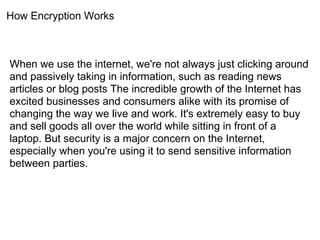
Week 12 slide
- 1. How Encryption Works When we use the internet, we're not always just clicking around and passively taking in information, such as reading news articles or blog posts The incredible growth of the Internet has excited businesses and consumers alike with its promise of changing the way we live and work. It's extremely easy to buy and sell goods all over the world while sitting in front of a laptop. But security is a major concern on the Internet, especially when you're using it to send sensitive information between parties.
- 2. Security Encryption Systems Computer encryption is based on the science of cryptography, which has been used as long as humans have wanted to keep information secret. Before the digital age, the biggest users of cryptography were governments, particularly for military purposes.
- 3. Symmetric Key In symmetric-key encryption, each computer has a secret key (code) that it can use to encrypt a packet of information before it is sent over the network to another computer. Symmetric-key requires that you know which computers will be talking to each other so you can install the key on each one. Symmetric-key encryption is essentially the same as a secret code that each of the two computers must know in order to decode the information. The code provides the key to decoding the message. The same goes for computers, but, of course, the keys are usually much longer. The first major symmetric algorithm developed for computers in the United States was the Data Encryption Standard (DES), approved for use in the 1970s. The DES uses a 56-bit ke
- 4. Public Key Encryption One of the weaknesses some point out about symmetric key encryption is that two users attempting to communicate with each other need a secure way to do so; otherwise, an attacker can easily pluck the necessary data from the stream. In November 1976, a paper published in the journal IEEE Transactions on Information Theory, titled "New Directions in Cryptography," addressed this problem and offered up a solution: public-key encryption. Also known as asymmetric-key encryption, public-key encryption uses two different keys at once -- a combination of a private key and a public key. The private key is known only to your computer, while the public key is given by your computer to any computer that wants to communicate securely with it. To decode an encrypted message, a computer must use the public key, provided by the originating computer, and its own private key. To implement public-key encryption on a large scale, such as a secure Web server might need, requires a different approach. This is where digital certificates come in. A digital certificate is basically a unique piece of code or a large number that says that the Web server is trusted by an independent source known as a certificate authority. It confirms that each computer is in fact who it says it is, and then provides the public keys of each computer to the other.
- 5. SSL and TLS A popular implemention of public-key encryption is the Secure Sockets Layer (SSL). Originally developed by Netscape, SSL is an Internet security protocol used by Internet browsers and Web servers to transmit sensitive information. SSL has become part of an overall security protocol known as Transport Layer Security (TLS).
- 6. How Encryption Works The key in public-key encryption is based on a hash value. This is a value that is computed from a base input number using a hashing algorithm. Essentially, the hash value is a summary of the original value. The important thing about a hash value is that it is nearly impossible to derive the original input number without knowing the data used to create the hash value. For example, there is a input number, it is 10,667, hashing algorithm is input # x 143, hash value is 1,525,381. From these data, we can see how hard it would be to determine that the value 1,525,381 came from the multiplication of 10,667 and 143.